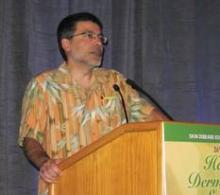WAIKOLOA, HAWAII – The improvement in melanoma survival over the past 4 decades can be attributed to effective public education campaigns, increased patient awareness, and improved physician skills and diagnostic tools, according to Dr. Ashfaq A. Marghoob.
It has been nothing short of phenomenal, he said, especially considering it can’t be credited to major therapeutic advances because up until a couple years ago there weren’t any.
Survival at 5 years for all-stage melanomas of the skin climbed from less than 60% in 1970 to 91% in 2011, he said at the Hawaii Dermatology Seminar sponsored by the Skin Disease Education Foundation (SDEF). But while this is a triumph deserving of celebration, the statistics are somewhat deceiving, said Dr. Marghoob, a dermatologist at Memorial Sloan-Kettering Cancer Center in New York.
He is among a growing number of experts who believe that many thin melanomas detected through screening efforts are slow-growing, indolent skin cancers that sometimes regress and in any event will never become thick or dangerous – never result in death – within the range of current life expectancy. He noted that there is ample precedence, namely, indolent forms of prostate cancer, lymphoma, and breast cancer.
Dr. Marghoob was part of an international team that demonstrated the existence of a slow-growing subtype of melanoma. In a series of 103 melanomas excised after a median follow-up of 20 months, most of the lesions were still in situ or in an early invasive stage. Only three lesions were 1-mm thick or more. There was no correlation between tumor thickness and follow-up time ( Br. J. Dermatol. 2010;162:267-73 ). Growing support exists among epidemiologists for the concept that there are three distinct, unrelated melanoma subtypes ( Br. J. Dermatol. 2007;157:338-43 ). One subtype consists of thin, slow-growing melanomas – the kind that have been steadily increasing in incidence for decades. These are associated with intermittent sun exposure and often arise on the trunk among numerous background nevi. These melanomas are amenable to detection via screening or periodic surveillance. But they only rarely metastasize.
A second type of slow-growing melanoma often occurs on the head and neck of individuals with continuous sun exposure. The incidence of this subtype of melanoma is slowly increasing.
The third and most concerning melanoma subtype consists of thick, fast-growing lesions occurring in individuals with many nevi, but that are not associated with sun exposure. The incidence of these fast-growing, high-lethality melanomas has remained steady over time because they often escape detection as a result of their accelerated growth rate. Improved early detection is a high priority, and it will require creative new approaches, he said.
But in terms of celebrating rising 5-year melanoma survival rates, a contributory landmark event, in Dr. Marghoob’s view, was the increased awareness about melanoma after introduction of the ABCD mnemonic, devised chiefly for primary care physicians and the general public. This was later enhanced by the "ugly duckling" campaign, which taught physicians and patients that melanomas are generally recognizable as outlier lesions.
Multiple studies have shown that skin cancer specialists using visual examination alone – incorporating the ABCDs and ugly duckling concept – can typically diagnose melanoma with a sensitivity of 70% and specificity of 75%. The number needed to treat (NNT) or benign-to-malignant biopsy ratio is 1:12-15.
With the aid of total body photography for assistance in patient follow-up, the NNT improves to 10.
Dermoscopy has been another important advance. It enables physicians to pick up melanomas not detectable by any other method. Skin cancer specialists who supplement visual examination with dermoscopy typically have 90% sensitivity and 86% specificity for the diagnosis of melanoma. The NNT improves to 4-7, Dr. Marghoob continued.
Recent studies indicate these numbers get even better with the use of confocal microscopy during skin examination.
Using a review of his own practice to illustrate the strong trend for improved diagnosis, Dr. Marghoob noted that in 1998 his NNT was 12.5. He adopted dermoscopy in 1999, and in 2000, when he was using dermoscopy routinely, his NNT improved to 7. During both 2006 and 2007 it was 3, he said.
"We have gotten better at diagnosing melanoma and we will continue to improve," he concluded.
He reported having no relevant financial disclosures. SDEF and this news organization are owned by Elsevier.


